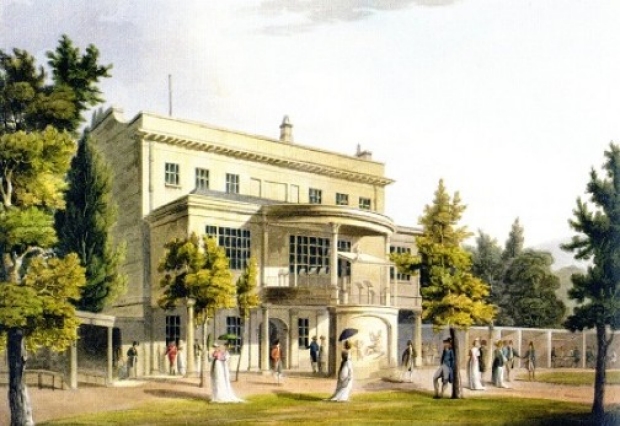notice
Lecture - Dr Cynthia Hammond: The Gardens will be Illuminated
 Sydney Gardens and rear of Sydney House, 1805. From Bath, A Series of Illustrated Views, published 1805 by William Miller.
Sydney Gardens and rear of Sydney House, 1805. From Bath, A Series of Illustrated Views, published 1805 by William Miller.
Dr Cynthia Hammond, Chair of the Department of Art History, is plenary speaker for the conference Georgian Pleasures, 12-13 September 2013, Holburne Museum, Bath, England. Her talk is titled 'The Gardens will be Illuminated': Gendered and Georgian Pleasures in the Sydney Gardens.
The eighteenth-century pleasure garden was a form of entertainment for men and women of all classes. If one had the entrance fee, one could enter and savour a stunning variety of diversions, from fireworks to live music to "illuminations" - marvelous structures lit by hundreds of tiny oil lamps. Dining out of doors in their best clothes, listening to nightingales sing, and watching every walk of life pass by, visitors to pleasure gardens such as Vauxhall in London and Sydney Gardens in Bath described these spaces as magical fairylands.
Others, however, denounced the ways these gardens encouraged illicit encounters and the mixing of social classes. The pleasure garden by paid entry was, in the Georgian era, a new type of social space and certainly an escapist one. But it was also a space that complicated the rising tide of Evangelicalism, a growing cult of domesticity for women, and a discourse on taste that sought to sever "the arts of taste" from rank or "effeminate" pleasures. Vital to the enactment and consumption of popular culture, pleasure gardens were wildly successful - even critics could not stay away. John Brewer describes women as the majority audience for these gardens' spectacles (2013, 73), raising the question of what, precisely, such gardens offered to women?
In her plenary lecture for the Georgian Pleasures conference, Dr Hammond examines the surviving evidence of Sydney Gardens in Bath, a pleasure garden operational between 1795-1845 and today the grounds of the Holburne Museum, Bath. Using the original designs of 1790, prints, plates, and descriptions of the era, Hammond considers the garden itself as a primary document for understanding the ways that these landscapes offered women new opportunities for pleasure, exertion, visual delight, and visibility. She argues that the landscape and design of the pleasure garden made it a place that produced new, gendered subjectivities, and thus they can be seen as key spaces within eighteenth-century women's individual and collective political identification (Barker and Chalus, 2005, 4). The conference is part of a series of events celebrating the re-opening of the former pleasure gardens, Holburne Museum, Bath.
Additional information
Thursday and Friday, 12-13 September 2013
The Bath Royal Literary and Scientific Institute and the Holburne Museum, Bath, England

